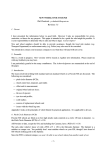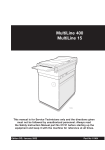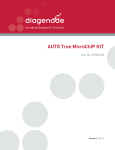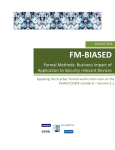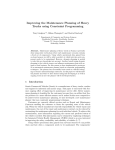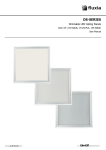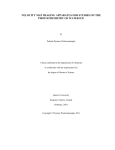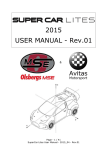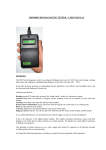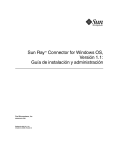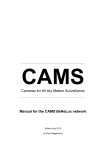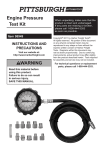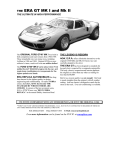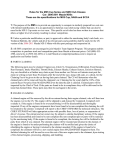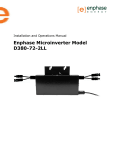Download NEW WHEELS FOR YOUR 928 Phil Chadwick. p
Transcript
NEW WHEELS FOR YOUR 928 Phil Chadwick. [email protected] Revision: 7.10 1. Caveat I have presented the information below in good faith. However I take no responsibility for errors, omissions, or fitness for any purpose. This paper is intended to be a guide for what might be possible. It is your responsibility to determine what is safe and what is legal. Caveat emptor! Tyre and wheel suppliers should be able to provide assistance, though the local rule makers (e.g. Transport Department) or enforcement entity (e.g. Police) may also need to be consulted. You should also contact your insurance company to see what they will (and will not) cover. 2. Preamble This is a work in progress. New versions will be issued as I gather new information. Please email me with any feedback you may have. I am grateful to the many contributors. The Acknowledgments are summarised at the end of the paper. 3. Introduction The issues involved in fitting both standard and non-standard wheels to a Porsche 928 are discussed. The following are considered: — pitch circle diameter (PCD); — wheel centre bore, diameter, and width; — offset and its measurement; — original wheel and tyre sizes; — the use of spacers; — tyre size and profile; — scrub radius; — sources of replacement wheels; and — issues with the wheel lug nuts. Appendix I looks at the principles of wheel fitment by practical application. It is applicable to all cars. 4. Pitch Circle Diameter (PCD) Porsche 928 wheels are fitted on to five high tensile studs centered on a circle 130 mm in diameter. i.e. the Pitch Circle Diameter (PCD) is 5 × 130. All Porsches to date, except the 924, and including the Boxster, Cayenne, Cyman, and Panamera have a PCD of 5 × 130. The only other vehicle I know of with a PCD of 5 × 130 is the Mercedes Sprinter. The Sprinter is a minibus or camper van. You probably don’t want minibus wheels on your 928, though I have heard of 928 wheels looking good on the Sprinter. Since the PCD is (almost) unique, you won’t be able to use wheels taken from another make of car. –1– Street side Car side Figure 1. PCD and Offset. Source: http://www.tyresave.co.uk/fitment.html For additional diagrams and explanations see also: www.halibrand.com/surefit/fitment.pdf 5. Centre Bore All Porsche wheels to date, except the 924 (up to the Panamera), have a centre bore of 71.5 mm (this is the diameter of the hole in the centre of the metal wheel). It has to be wide enough to accommodate the grease cap. 6. Wheel Diameter This is the diameter of the metal wheel at the point where the tyre bead sits (which excludes the flanges which hold the tyre beads in place). Porsche didn’t recommend 17" wheels until they introduced them on the GTS. Porsche do not now recommend wheels greater than 17" diameter for the 928. 17" upgrades to older models are now common, 18" less so (but certainly exist). Fitment for a 19" wheel requires an extremely low profile tyre (see Tyre Size and Profile below) e.g. 255/30−19 to 275/30−19. These are rare and likely to cost serious cash. The lower the profile: — the less the sidewall is able to flex to contribute to a supple ride; — the more likely the rim is to be damaged by pot-holes; and — the more expensive the tyre. So, spend some thought and check tyre prices and availability before you choose wheel size! 7. Wheel Width This is the width of the metal wheel measured from bead seat to bead seat (this excludes the flanges which hold the tyre beads in place). Original wheels ranged from 7" to 9" wide. See Table 4. –2– The maximum possible metal wheel width rims are 9½" front and 11" rear. These are pretty aggressive, and require expert fitting. The maximum tyre width I have heard of on the front, on stock (non-GTS, non-flared) guards, is 265 mm. It’s 295 mm on the rear. However 255 mm and 285 mm might be safer working limits. Tyre width has to be matched to the metal wheel width. Marc Thomas from Devek [Rennlist mailing list] said that he thought the ideal ratio for tyre to wheel width was in the range 0.85:1 to 1.15:1, with the 1:1 likely to be ideal for best handling (though some will certainly prefer maximum tyre width): Rim Width 7" 8" 9" 10" 11" Width of Rubber Tyre Minimum Optimum Maximum 150 mm 175 mm 205 mm 175 mm 205 mm 235 mm 195 mm 230 mm 265 mm 215 mm 255 mm 290 mm 240 mm 280 mm 320 mm Table 1. Optimal Tyre Width for Various Rim Widths Make sure that you check what’s recommended by the tyre manufacturer and also what’s legal (and recall that the absolute maximum possible tyre width with un-flared guards is 265 mm front and 295 mm rear). 8. Wheel Offsets Offset is the distance between the plate in the centre of the wheel that bolts onto the hub, called the ‘‘mounting pad,’’ and the (imaginary) plane which bisects the tyre into two equal doughnut shaped halves. See Figure 1. Offset determines scrub radius on the front of the car (see Scrub Radius below). In conjunction with tyre width, offset also determines both inner and outer wheel arch clearance of both front and rear tyres. Cars almost always have positive offsets, i.e. the metal wheel is roughly saucepan shaped (without handle or lid) with the base of the saucepan facing outwards. Negative offsets, which are common on trucks and 4-wheel drives, occur when the mounting pad plane is closer to the centre of the car than the centre line plane (i.e. the bottom of the saucepan is pushed in towards the vehicle more than half way). I have from ‘‘reliable here say’’ [Ed Ruiz — Rennlist mailing list] that the following work on ordinary 928s (i.e. without the flared guards of the GTS): — front: 235/45−17 on an 8" rim with a +70 mm offset; and — rear: 275/40−17’s on a 9" rim with a +55 mm offset. You can go a fair bit wider than this. If you can get professional advice and/or are able to experiment with offsets, the best starting point I have is sourced from Kim Crumb [Rennlist mailing list]: Front Rear Offset +65 to +68 mm +52 to +60 mm Max Tyre Width 265 mm 285 mm Table 2. Offsets for Maximum Tyre Widths. The widths shown above are the maximum possible for a standard outside tyre diameter of 25", for nonGTS models, by custom fitting wheels (without modifying the guards). Table 2 tells you every thing you need to size your new wheels and tyres provided that you maintain the –3– ‘‘basic assumptions’’, namely: — the outside diameter of 928 tyres needs to be very close to 25"; — that 9.5" is the absolute rim width limit at the front; — that 11" is (probably) the absolute rim width limit at the rear; and — also provided that the tyres are wider than the rims. More recent Rennlist postings by Kim Crumb and David Roberts have been more specific. In particular, Dave posted saying: Here is what I currently use on my street 90GT with no clearance issues and ride height below spec: — 9.5"×18" front with 68.5 mm offsets and 255/35-18 tyres — 11"×18" rear with 54 mm offsets and 295/30-18 tyres This information allows us to derive some useful clearance limits on late model S4s and GTs, with factory rolled guards (as long as the tyres are always wider than the rims). The same limits should be applicable to earlier models, but it would be necessary to ‘‘roll the guards’’. The clearances are: Front: Rear: 9.5"×18" ET68.5 wheels, 255/35-18 tyres Protrusion from mounting pad to inside tyre wall: Protrusion from mounting pad to outside tyre wall: 11"×18" ET54 wheels, 295/35-18 tyres Protrusion from mounting pad to inside tyre wall: Protrusion from mounting pad to outside tyre wall: 68.5 mm + 127.5 mm = 196.0 mm 127.5 mm - 68.5 mm = 59.0 mm 54.0 mm + 147.5 mm = 201.5 mm 147.5 mm - 54.0 mm = 93.5 mm Table 3. David Roberts 1990 GT Wheels and Tyres The above clearances are derived from the offset and (half the) tyre width. It helps to draw a diagram of the wheel and tyre to understand the geometry. Note that tyres with rim guard beads may have reduced arch clearance. The positioning of the tyre (relative to the car) is determined by offset and tyre width alone (within the bounds of our ‘‘basic assumptions’’, above). In particular, the diameter of the metal wheel is not relevant to wheel arch clearance. Armed with offset and tyre width, the protrusions for any wheel and tyre may be calculated and compared to the above. There is no particular offset requirement for the rear of a 928 apart from that dictated by aesthetics and wheel arch clearance (which is certainly the issue in Table 3). Also, on the rear, any combination of wheel offset and spacer may be used to achieve the stated (effective) offset, but note that spacers always reduce the effective offset of 928 wheels. Spacers for the 911 fit a 928 because they both have the same PCD. The factory spacers, either with their own studs or those with longer studs inserted into the hub, are all ‘‘hub centric’’ — i.e. they have a recess for the annulus on the hub to seat in, and an annulus on the wheel side to go into the centre of the wheel. Flat plate spacers shouldn’t be used. [Jon Holdsworth — Landshark mailing list.] Please bear in mind that wheel shape is an issue, most particularly in relation to brake caliper clearance. Also, manufacturers’ stated tyre widths and profiles may not be absolutely reliable, or closely comparable, especially between brands. See Using Other Porsche Wheels, below, for more information on offset. –4– 9. Original Porsche 928 Wheel and Tyre Sizes Table 4 shows the details of the wheels, tyres, offsets and spacers shipped from the factory with the various 928 models. Factory fitting of RDK (tyre pressure warning system) commenced with the introduction of the ‘‘digital dash’’ in Model year 1989 (commencing August 1988), though possibly not standard for all countries, and ceased at the start of Model year 1994 (August 1993). Model Year 928 1977–1982 928S 1980–1986 928S4 1987–1991 928CS/SE/GT 1988–1989 928GT 1990–1991 928GTS 1992–1993 928GTS 1994–1995 Option M347 928S Option I393 928S4/GT Option M395 928S Option M400 928S4/GT Option M401 928 Option M415 928S spacers Wheel Type Phone Dial, Cast Aluminium Alloy 7-Slot Forged 7-Slot Forged Club Sport, Forged Magnesium Alloy Design 90 Cast Aluminium Cup 1 (cast) Cup 2 (cast) 7-Slot, Forged Platinum Anodized Club Sport, Forged Magnesium Alloy 7-Slot, Forged Silver Anodized Design 90 Cast Aluminium Phone Dial, Cast Aluminium Alloy Size(F/R) 7"×15" 7"×15" 7"×16" 7"×16" 7"×16" 8"×16" 8"×16" 9"×16" 7½"×16" 9"×16" 7½"×17" 9"×17" 7½"×17" 9"×17" 7"×16" 7"×16" 8"×16" 9"×16" 7"×16" 7"×16" 7½"×16" 9"×16" 7"×16" 7"×16" Tyre Size(F/R) 215/60VR15 215/60VR15 225/50VR16 225/50VR16 225/50VR16 245/45VR16 225/50VR16 245/45VR16 225/50ZR16 245/45ZR16 225/45ZR17 255/40ZR17 225/45ZR17 255/40ZR17 225/50VR16 225/50VR16 225/50VR16 245/45VR16 225/50VR16 225/50VR16 225/50ZR16 245/45ZR16 225/50VR16 225/50VR16 Offset (mm) +65.0 +65.0 +65.0 +65.0 +65.0 +52.3 +60.0 +60.0 +65.0 +52.3 +65.0 +55.0 +65.0 +55.0 +65.0 +65.0 +60.0 +60.0 +65.0 +65.0 +65.0 +52.3 +65.0 +65.0 Spacer Size – – – – – – – 17 mm – – – 35 mm – 35 mm – – – 17 mm – – – – – – – 21 mm Table 4. Original Porsche 928 Tyre Fitments. 10. Determination of Offset Genuine Porsche wheels have the offset cast on them. Look near the valve seat for markings like ‘‘ET65 7.5’’ which indicates a 65 mm offset and a 7.5" wide wheel. The ‘‘ET’’ stands for ‘‘Einpress Tiefe’’ (offset). [Theo Jenniskens — Rennlist mailing list.] You may also find cast markings on the ‘‘inside’’ of the wheels (the area hidden by the spokes that’s very difficult to clean). It is possible to measure the offset with the wheel removed from the car. You will need a good straight edge and a 3 foot rule or metal tape measure: –5– — place the wheel on the ground, street side down; — place the straight edge across the wheel so it sits flat on the metal rim; — measure the distance from the mounting pad to the straight edge — this is the backspacing, call it B; — turn the wheel over, car side down, and repeat the process, measuring from the same (now lowest) point on the mounting pad as used previously — this is the frontspacing, call it F. The total width of the wheel, call it T, is given by the equation: T=B+F This will be greater than the ‘‘conventional’’ width because it includes the flanges which hold the tyre beads in place. The offset, call it O, is given by the equation: O = B − (T ÷ 2) It’s possible to use this procedure even if the straight edge is held proud of the rim by the tyre. To measure backspacing, just rest the straight edge on the tyre. Measure the distance from the mounting pad to the straight edge. Then measure the distance from the rim to the straight edge (do it at each of the two points where the straight edge crosses the rim, and take the average). To get the backspacing, subtract the second measurement from the first. Apply a similar procedure to get the frontspacing. 11. Using Spacers You can use a spacer between the wheel and the wheel hub to reduce a positive offset. This will: — move the wheel away from the centre of the car, closer to the wheel arch body panel; and — increase clearance between the wheel and the brake calipers. Spacers come in two versions, namely simple insert-discs with the 5 × 130 hole pattern; and thicker discs that bolt onto the wheel hub (5 separate nuts), and have 5 bolts that stick out and mount the wheel using the wheel lugs. [Theo Jenniskens — Rennlist mailing list.] Both types of spacers will generally require that the original studs be changed. Porsche used spacers when they installed wide wheels inside the flared guards of the GTS. i.e. they increased the rear tyre width by 10 mm, used spacers to reduce the offset of each rear wheel and thus moved each rear wheel outwards from the car to (more or less) centre it within the newly flared guards. It’s worth repeating that using a spacer will always decrease a positive offset. e.g. a 15 mm spacer will reduce a +65 mm offset to a +50 mm offset. This is relevant because other Porsches generally have wheels with offsets smaller than those used on the 928. When such wheels are fitted to a 928, the use of spacers will only make that offset even smaller. The moral of the story is that you can’t use a spacer to increase a positive offset (not, at least, without deploying some anti-matter), but read on... 12. Tyre Size and Profile A tyre specification will usually look something like ‘‘245/45 R 16 94W’’. The first figure is the tyre width. In the example above the width is 245 mm. This figure refers to the tyre width not the tread width. The next number is the tyre aspect ratio. It is the ratio of height:width. The above example has a hight of 45% of 245 mm. (110.25 mm). If the tyre was a 225/50R16 it would be 50% of 225 mm (112.50 mm). This two digit figure is referred to as the tyres series. For example ‘‘45 series tyres’’. –6– Next is usually the letter ‘‘R’’. This identifies the tyre as having a radial ply construction. If it was the older style cross ply construction it would be identified with the letter ‘‘D’’. With the prevalence of radial ply tyres, it is not unusual to see the speed rating (see below) in place of the ‘‘R’’, e.g. 245/45ZR16. Next is the diameter of the metal rim. Our example size was a rim diameter of 16". Rim diameters are always measured in inches. Next comes the load index. This refers to the maximum load for which tyre is designed. Below is a table of Load Index values. Remember these are the maximum load for each tyre with the car fully loaded. Our example has a load index of 94, so it is designed to carry 670 kg per tyre. Index 75 77 79 81 83 85 87 89 91 93 95 97 99 Load 375 kg 412 kg 437 kg 462 kg 487 kg 515 kg 545 kg 580 kg 615 kg 650 kg 690 kg 730 kg 775 kg Index 76 78 80 82 84 86 88 90 92 94 96 98 100 Load 400 kg 425 kg 450 kg 487 kg 500 kg 530 kg 560 kg 600 kg 630 kg 670 kg 710 kg 750 kg 800 kg Table 5. Tyre Load Index Values. Finally is the speed rating, which describes the speed at which the tyre is designed to operate. The following is a list of speed indexes as found on passenger car tyres. Our example has a speed rating of ‘‘W’’ so it is designed to operate at a speed not to exceed 270 km/h. Symbol N P Q R S T U H VR ZR V W Y ZR+ W ZR+ Y Meaning speed not to exceed 140 km/h (87 miles/h) speed not to exceed 150 km/h (93 miles/h) speed not to exceed 160 km/h (99 miles/h) speed not to exceed 170 km/h (106 miles/h) speed not to exceed 180 km/h (112 miles/h) speed not to exceed 190 km/h (118 miles/h) speed not to exceed 200 km/h (124 miles/h) speed not to exceed 210 km/h (130 miles/h) for speeds over 210 km/h (130 miles/h) for speeds over 240 km/h (149 miles/h) speed not to exceed 240 km/h (149 miles/h) speed not to exceed 270 km/h (168 miles/h) speed not to exceed 300 km/h (186 miles/h) for speeds over 240 km/h but not exceeding 270 km/h for speeds over 240 km/h but not exceeding 300 km/h Table 6. Tyre Speed Ratings. The VR and ZR speed ratings are largely obsolete, but still retained by a few tyre makers (for what I assume are marketing reasons). The nominal outside tyre diameter is equal to the diameter of the metal wheel plus two times the height of –7– the sidewall. e.g. for a 245/45-16 tyre it is 16" plus 2 × (45% of 245 mm), which is 16 + (2 × 110.25 ÷ 25.4) = 24.68". When changing wheels and tyres, it’s very desirable to maintain (outside) tyre diameter within 2.5% of the diameter of the original equipment tyres. Thus, if we increase the diameter of the metal wheel, we must reduce the height of the tyre sidewall (lower the profile) in sympathy. Note that changing the overall tyre diameter will change the gearing of your car and the accuracy of the speedometer. A 2.5% variance in the diameter is usually acceptable, but check with your local authorities to determine what is legal (and remember that your speedo will read low if the tyre diameter is increased)! See Appendix II for a list of tyre sizes comparable to the original 928 equipment. BMW 7 series devotee, Chris Koch [http://www.bmwseven.com] advised: ‘‘...tire sizes (such as 245/45VR16) and the mathematical relationship the sizes indicate hasn’t been true for at least a decade. You must ignore the ‘‘math’’ of 245 mm wide with a sidewall height of 45%. Instead you must follow the published specifications for each tire size within each tire model and pay particular attention to the revs/mile.’’ This is good advice and should be followed where ever possible. Revs/mile is a much more accurate comparator for tyre diameter than the nominal geometry. Sadly, revs/mile ‘‘published specifications’’ may not always be available for the factory fit tyres in your User’s Manual. 13. Scrub Radius Steering Axis Inclination (SAI) is the measurement in degrees of the steering pivot line when viewed from the front of the vehicle. Included angle is the angle formed between the SAI and the camber. Scrub radius is the distance between where the SAI intersects the ground and the center of the tire. Where the centre of the tyre is outside the line of the SAI, the scrub radius is positive, as in Figure 2. The scrub radius on the 928 is negative, with the centre of the tyre inside the line of the SAI (see Figure 3). Figure 2. Included Angle, Steering Axis Inclination, and Scrub Radius. (Source: http://www.familycar.com/alignment.htm) Commencing about 1986 (1986.5 in the US, the S3 in Australia, and certainly by the introduction of the S4 in all markets) 928s were fitted with 4-piston Brembo front brakes. With the ‘‘big brakes’’ came revised suspension geometry. In particular, the scrub radius was reduced from -16 mm to -10.2 mm. See Figure 3. The negative scrub radius is imparted by the large positive front wheel offset. The relationship between offset and scrub radius is direct, i.e. for each 1 mm reduction in positive offset, negative scrub radius magnitude is reduced by 1 mm. –8– On cars with ‘‘big brakes’’ the negative scrub radius will be lost if a front wheel with an offset of less than +54.8 mm is fitted. On older cars, negative scrub radius is lost when the front offset is lowered to below +49.0 mm. The negative scrub radius is a significant design feature of the 928, imparting stability and controllability to the car’s steering, especially at times when it is most needed. When there is uneven drag on the front wheels — for example, if one is going through water or mud, and the other isn’t; or one has low pressure, and the other doesn’t; or the ABS is releasing one front wheel and not the other — the wheel with the greater drag will be turned inward, countering the greater drag on that side of the car ie the steering is selfcorrecting, to some extent. If the scrub radius is positive, greater drag will turn the wheel outward, adding to the tendency for the car to pull in that direction [Glenn Evans — Landshark mailing list]. Figure 3. Porsche 928 Scrub Radius (Model Year 1986 and later). 14. Wheel Weights Porsche made really light factory wheels. They also fitted aluminium wheel nuts, so they thought that unsprung weight was a big deal. If you care about handling, you should too, so weigh before you buy. My factory club sport 1989 GT wheels weigh (emperically, with my bathroom scales, rounded to nearest 100 g): — front 8"×16" wheel, 225/50-16 ContiSportContact N1 (35% wear): 19.4 kg — rear 9"×16" wheel, 245/45-16 ContiSportContact N1 (near new): 21.0 kg Tirerack has specification sheets for Continental ContiSportContact tyres. These are not specifically N1 compound, but are the closest I can find: — 225/50-16: 22 lb = 10.0 kg — 245/45-16: 24 lb = 10.9 kg Using the published tyre weights above, and ignoring wear, the club sport wheels on the GT weigh approximately: — front 8"×16": 19.4 kg - 10.0 kg = 9.4 kg — rear 9"×16": 21.0 kg - 10.9 kg = 10.1 kg 1988 S4 flats without tyres weigh (with the same bathroom scales): — front 7"×16": 9.0 kg — rear 8"×16": 9.5 kg ‘‘Aim for no more than 10 to 12 kg per wheel, without tyre.’’ [John Cumming — Australian landshark mailing list.] ‘‘My design 90s with tyres weigh 19.7 kg front and 20.7 kg on the rear. Early flats on a S4 weigh 18 kg. My sons expensive lightweight 18" wheels and tyre on his FTO weigh 22.8 kg, [however he replaced them with] a forged set of 17 x 7" with Kumhos 712s that weigh 17 kilos. The difference in performance was remarkable.’’ [Graham Bates — Australian landshark mailing list.] –9– 15. Using Other Porsche Wheels On the front, the offset determines the scrub radius and thus where the tyre contact patch is in relation to the ball joints. For proper steering response, regardless of wheel width, you really need the offset to be as close to the factory +65 mm (ET65) as possible. Changing the offset of the front wheels can cause undesirable side effects. Tram tracking, instability etc. are likely to be noticeable before you have clearance problems. Offset is not really an issue on the rear wheels. The S4 and later (see Table 4) have smaller rear offsets and are easier to fit, but it’s the front wheels that will constrain the choice of brand and style. Wheels made for the 911 and Boxster have the correct centre bore (71.5 mm) and PCD (5 × 130) for the 928, but their offset (traditionally 25 to 45 mm) is too small for the front. They may also foul the 928 brake calipers, thus requiring spacers which reduce the offset even further. However, some of the 993, 996, and Boxster 17" wheels have become available with +55 mm offsets. This is tantalisingly close to the 928’s standard +65 mm (and even closer to the +60 mm offset used on the front wheels of the 1989 928 GT). I have heard that the wheel nut cover plates on some 17" Boxster wheels foul the front axle grease caps when fitted to a 928. [Doug Hillary — pers. comm.] So much for theory, but what are people actually doing? I have seen many reports of 911 and Boxster wheels fitted to a 928. e.g. from Mike Readman on the UK 928 mailing list: ‘‘My experience and preference wheel tyre set up on the S4 is 993 rims 17" × 7" and 9" with 55 offsets. 20 mm spacer on the rear... The tyres I am using are Pirelli Pzero. Front being 225/45−17 N2. The rears are 255/40−17 N2. ‘‘Wheel arch clearance on the front is fine obviously due to the shape of the body. On the rear it is certainly at the max but I have not experienced any bodywork contacts, this is without removing the arch ‘folding roll’ as some have suggested.’’ And this from Math Creemers, also from the UK 928 mailing list: ‘‘1987 S4, wheels came from a 993, size and offset are stamped next to the valve: Front: 7J offset 55 mm, Conti 225/45R17 Rear: 9J offset 70 mm and 21 mm spacers, Conti 255/40ZR17’’ And this from Mark Moss, also from the UK 928 mailing list: ‘‘I’ve been running some 18" sports classic wheels taken from a 996/Boxster on my ’89 GT. ‘‘The are 8J×18 on the front and 10J×18 on the rear. Not sure on their offset values as that’s a bit techie for me. I understand what you are all saying but don ’t know how to find out what offset they are. I’m sure someone out there will know. ‘‘Tyres 225/40×18 Front and 265/35×18 on rear. The fronts fitted fine while I need 18 mm spacers on the rear (fitted by a independent Porsche garage). The rears just fit with minimal clearance on the wheel arches. I can get my fingers between the tyre and wheel arch. The wheel arch has not been changed or modified.’’ Also this from Martin Dunks on Rennlist: ‘‘I have just put Boxster/996 18" 7.5 & 10 BBS sport classic II’s on my car. Bolted straight on, no spacer, no problems’’ David Porter from the UK 928 mailing list in response to my request for more data points: ‘‘Just fitted a set of 17" 996 wheels (55mm offset) on Contis to my S4. Phil — no clearance, bump- – 10 – steer or straight-line stability problems. Bought them from Porsch-apart who allowed me to try before buy as I was a little concerned. See: http://www.928sg.com for the design.’’ So, some people use 993, 996 and Boxster wheels on the 928, apparently with great success. However some very well informed people are quite negative on the issue. For instance, Kim Crumb, well known and respected on Rennlist, is adamant that 911 wheel geometry is wrong for the 928: ‘‘... 52 offset or something ... so the tire has been moved out an half inch ... that doesn’t work on the front of 928s ... one implication is that it means there’s no availability of any inexpensive wheels that would properly fulfill that [928 front wheel] application ... sorry.’’ This from Mark Edwards on the Australian landshark mailing list: ‘‘The first wheels that I had on my GT courtesy of the previous owner were Mille Miglia cup 2 replicas ET47 & 52. I was not happy with them as they were scratched and I believed much heavier than the originals. I got a real set of cup 1’s ... and couldn’t believe how much more stable the car was.’’ I have had a wide range of other negative comments about instability when the offset is too small. They have ranged from ‘‘no worse than Weisach axle steer’’ to ‘‘so dangerous, I wasn’t game to go over 60 kph.’’ Straight line stability may be impacted by quite a few things apart from offset, e.g. tyre age, tyre wear, ride height adjustment, wheel weight, wheel alignment, shock absorber type and condition, springs (and their matching with the shock absorbers), steering rack condition and mounting, sway bar bush wear, and other front end component wear. So it’s difficult to sort all the issues quantitatively (tyres, wheel alignment, and ride height are the big ones [Bruce Buchanan — Australian landshark mailing list]). But we can make some conclusions... The smallest front wheel offset Porsche ever shipped on a 928 was 60 mm on the early GTs and Club Sport. So 60 mm should be OK, but do note that the factory only ever did this in combination with very light magnesium wheels (9 kg, without tyre [John Cumming — Australian landshark mailing list]). Club Sport wheels are really quite rare but, at 60 mm, they do set a very significant precedent and beg the question ‘‘how low can we go?’’. I have not heard a single complaint from anyone actually using 55 mm front offsets (there are really quite a few of them and I have been asking everyone I found). However, some of the problems associated with reducing the scrub radius (and front offset) may only appear in ‘‘adverse’’ driving conditions. And, not everyone may actually undersdtand how very stable a 928 can be. The complaints commenced at 52 mm (often in conjunction with heavy wheels) and were numerous at 47 mm. This is entirely consistent with the scrub radius information provided independently (and much later) by John Cumming and Glenn Evans. To get 65 mm ‘‘factory spec’’ wheels, you either can buy a wheel made specially for a 928 or you can make one from a 3-piece wheel. These are the only options, and both are relatively expensive. Some 911 turbo models (circa 996 and later) are using rear wheel offsets in the range 65 mm to 70 mm. As far as I can see these wheels are all at least 10" wide, and thus won’t fit on the front of a 928. If I was paying list price, I would insist on minimum 65 mm offsets. However if I got offered genuine (light weight) 911/Boxster wheels that I liked with 55 mm offsets at the right price, I would probably take them.... but only on approval. I would absolutely not use front offsets less than 55 mm. – 11 – 16. Using Replica Porsche Wheels The same advice applies to replica wheels as to the genuine article. There are two additional specific issues: — check manufacturing quality (get references from happy users); and — some replicas (e.g. the Porsche factory licensed replica cup wheels) are extremely heavy, so check the weight. You will want to get the lightest (and strongest) wheels possible to minimise the unsprung weight. Heavy wheels rob horsepower and cause sluggish handling. 17. Wheel Lug Nuts The 928 wheel lug nuts are a M14×1.5 (14 mm thread diameter with 1.5 mm pitch) and made of aluminum. They are of very good quality, but being aluminium means that they require special care. The workshop manual (page 44–19) specifically states that wheel nuts may only be loosened and tightened with ‘‘Special Tool P 300’’ in ‘‘perfect condition’’ and that the aluminum nuts could shear through: — use of unsuitable tools (wheel nuts held by only about ²/³ of total depth), — excessive tightening torque, — erratic loosening (impact tool), and — missing or unsuitable lubricant. ‘‘Special Tool P 300’’ is a 14 mm hexagonal socket wrench which only touches the wheel nuts in the middle of the flats, and which is deep enough to cover the entire nut. Use one. Never allow the lug nut be tightened with an impact wrench (the air powered tools, favored by tyre shops, that sound like a jackhammer). The nuts should be torqued to 130 Nm or 95 ft lb. In the 928 Workshop Manual Porsche recommend lubricating the threads with Optimoly TA paste. Optimol, a German Company, was taken over by Castrol many many years ago. Optimoly TA is now called Optipaste TA and is available in 400 g spray cans, and 500 g or 5 kg containers from Castrol distribution outlets. Another very similar product is Mobil’s Greaserex RGM-2. [Doug Hillary — Australian landshark mailing list.] Both Porsche and BMW specified Optimoly TA for wheel nuts on wide variety of models. A 100 g tube from an official parts outlet should not be too expensive, and should last decades. [I got given about 50 g in 1974 to lubricate the spark plugs of my Mazda RX4 and it ran out in about 2003...] Never use a copper based grease such as ‘‘coppercoat’’. The copper reacts with water and bonds the aluminium nut to the steel studs. If your wheels have a thicker than normal mounting pad or you place a spacer between the wheel and the hub, the lug nuts need to make at least seven full turns to be safely seated. Also, if you use extra-long studs, typically with non-standard wheels, the lug nuts can only be turned about twelve times before the cap of the closed nut hits the stud [Ed Ruiz — Rennlist mailing list]. 18. 928 Wheel Fitment Summary For the 928, you need to specify a PCD of 5 × 130, with a centre bore of 71.5 mm. Front offset is +65 to 68.5 mm and rear offset +40 to +65 mm. The wheel diameter will usually be 17" or 18". Maximum sensible wheel width (with professional fitting and without flared guards) is 9½" front and 11" rear, but many will settle for less (e.g. 9" front and 10" rear). – 12 – Your choice of wide wheels is almost always going to be limited by what’s available for the front with a +65 mm offset. Even though other Porsche wheels may have the correct PCD, small front offsets may be a safety problem. 17" wheels from the Porsche 993/996/Boxster are used by many, but with spacers generally required on the rear, and some limitations to tyre width. Many attest to +55 mm offsets working fine. However, with front offsets lower than the +65 mm factory spec, there is a very real prospect of stability problems. The smaller the offset, the bigger the problem is likely to be. Front offsets smaller than +50.0 mm on older cars (without 4-piston Brembos), and +55.0 mm on newer cars (with 4-piston Brembos) may be problematic to the point of dangerous. Watch out for replicas which weigh more than the original wheels. You do not want to increase the unsprung weight. Avoid wheels that weigh more than 10 to 12 kg (without tyre). One choice is to shop for off-the-shelf 928-specific wheels. They can be found at 928 specialists, e.g. www.928gt.com, www.928intl.com and www.devek.net. If you have the cash, you can also head straight for the 3-piece wheel manufacturers. They can custom build what ever you want. In Australia http://www.simmonswheel.com.au/range.html is worth a look, given that you can specify offsets, widths etc. and the weights are very good (10kg). Have a look at the model FR17, especially the colour options. Less than Aus$600 per wheel [John Cumming — Australian landshark mailing list]. – 13 – 19. APPENDIX I — GENERAL FITMENT To demonstrate the general principles that usually apply to acquiring new wheels, I have set out in this section the process I went through when buying used mag wheels for my VW Golf III. This was a learning process for me, but it was fun and I got Aus$2000 worth of slightly used tyres and wheels for $Aus800.00. A worthwhile outcome. Use what ever resources you have to figure out the metal wheel diameter, width and style you want. First call your insurance company and find out what they will allow. Then get brochures, talk to friends, go to car meets, talk to professionals, search the Internet, and don’t forget to price suitable tyres. The Golf had 14" wheels fitted in the factory. I wanted the ‘‘big wheel, low profile’’ look, suggesting 16" or 17" wheels, but was constrained by the (usual) need to maintain tyre diameter with in the 2.5% variance from ‘‘stock’’. The very low profile tyres required for 17" wheels were just too expensive (a common outcome when you try to increase metal wheel diameter by more than 2"). Had tyre price been a really serious issue, I would likely have settled for 15" wheels. I found plenty of 16×7" (16" diameter, 7" wide) and some 16×7.5" third party new Golf wheels advertised the Internet, with tyre sizes up to 225/40−16. This set my nominal upper limit on the width of 16" tyres for wheel arch clearance at 225 mm. To go further would have required professional advice and fitment — I had a small budget and wanted to stay within the ‘‘common’’ commodity wheels and tyre sizes. I then got fitment data from: http://www.tyresave.co.uk/fitment.html The summary for the Golf was: Golf III: PCD 4×100; Offset 32–38; C/Bore 57.0 All wheel suppliers have these tables. These data were essential to figure out what fitment was required for the Golf and what other cars could supply used wheels for the Golf. The Golf requires a wheel with a centre bore of 57 mm (i.e. a hole of 57 mm diameter in the centre of the wheel). This is not an issue with most commodity wheels. The manufacturers make such wheels with a large centre bore and produce removable adaptor rings for each type of car that the wheel is likely to fit. The Golf pitch circle diameter (PCD) is 4 × 100 (4 studs centered on a circle 100 mm in diameter), a very common setup for small front wheel drive cars. The Golf wheel offset (the distance between the plate in the centre of the wheel that bolts onto the wheel hub and the [imaginary] plane which bisects the tyre into two equal halves) is typically +35 mm, but the acceptable range is +32 to +38 mm. I compiled from the fitment data tables a list of vehicles with similar wheel fitments to the Golf (4 × 100 PCD, offset around +35 mm). A list of suspects was ferreted from the ‘‘Trading Post’’. These included: Mags. 4 of 16×7 Viper, 205/45−16 Falken FK451 tyres, suit Honda Civic. Mags. CSA, 16×7, 5 spoke, 195/45−16 Goodyear F1 tyres. Suit Mitsubishi Lancer. A quick check of the fitment tables shows: Honda Civic: PCD 4×100; offset 35–38; C/bore 56 mm. Mitsubishi Lancer: PCD 4×100; offset 35–42; C/bore 56 mm. The offset of the Lancer might be as high as 42 mm and the limit for the Golf is 38 mm. So the offset on – 14 – the Lancer wheels would need to be checked (actually, they are mostly 35 mm, since that fits so many small front wheel drive cars). Otherwise the fitment looks good for both options. Two different types of tyre were sold as original equipment on the Golf. These were: 175/65−14 diameter 22.96" (583.2 mm) 185/60−14 diameter 22.74" (577.6 mm) The used tyres advertised with the mag wheels were: Falken 205/45−16 diameter 23.26" (590.8 mm) Goodyear 195/45−16 diameter 22.91" (581.9 mm) [See Appendix II for the method to calculate tyre diameter.] Both the Falken and Goodyear tyres are within 2.5% of the diameter of the original equipment tyres. Excellent! The local laws say that the tyre diameter may not increase by more than 15 mm, nor decrease by more than 26 mm. So both sets of used tyres are sensible for my car and legal to boot! It was now time to try fitting the wheels to the car. There are several reasons you must do this before buying. They are: — there’s no substitute for eyeballing the final result (I would never have chosen 16-spoke mags from a catalogue, but they look terrific on the car); — you must check for brake caliper clearance, front and rear; — you should check inside and outside wheel arch clearance, front and rear; and — you must check that the bolts/studs are the right size (mine were M12 1.5) and that fitting hardware will (or can be made to) work. You may need to remove the centre bore adaptor rings for the test (if their inside diameter is too small for your car). I bought the Vipers. Both the wheels and the tyres were in excellent condition and the fitment was perfect. At 205 mm wide they were well under 225 mm wide to comply with my notional upper limit for wheel arch clearance. The Vipers are a common brand and centre bore adaptor rings are readily available. I removed the old plastic 56 mm rings at the time of the trial fitting. I purchased new 57 mm aluminium ones from a local wheel retailer. The Vipers came with 16 chrome nuts, but the Golf needs bolts. The ‘‘factory standard’’ bolts already on the car are pretty ugly when exposed by removing the hub caps. Also, they don’t fit into the bolt-head recess in the new mags. I bought 16 chrome bolts from one of the local wheel retailers. The other, slightly cheaper, option was to buy 16 studs and lock-tite the chrome nuts to the studs (to form a bolt). However this would have been less convenient, less reliable, less safe, and maybe not legal. I was lucky to be able to buy high tensile chromed M12 1.5 thread bolts off the shelf to fit the wheels onto the car. These bolts are commodity in this size because so many small cars use them. However, since wheel attachment hardware is rated high tensile, and custom made high tensile hardware is very expensive, you would be very wise to sort out the attachment hardware needs and costs before committing to buy wheels. The new wheel attachment hardware (adaptor rings and chrome bolts) cost me Aus$100. That did not include locking nuts to deter thieves. – 15 – I should have waited for the new Koni shocks to arrive so that the wheels could be balanced and aligned at the same time as the shocks were fitted. But I couldn’t wait. The rear wheels required a 6 mm thick washer to be inserted between the wheel and the 3" wide plastic ‘‘Viper’’ decorator cap in the centre of the wheel. I used 1 mm gasket material from ‘‘Super Cheap Auto’’ to make the ‘‘washers’’ (6 layers). Check for this, lest you crack the cap when bolting on the wheel (like I did). If I didn’t own a 928, I’d say the Golf handles pretty well. – 16 – 20. APPENDIX II — COMPARABLE TYRE SIZES FOR PORSCHE 928 Table 4 shows the original equipment Porsche 928 wheel and tyre sizes. The table below shows other fitments within 3.25% of original equipment size for every tyre in Table 4. You may use this table to find all the ‘‘close fit’’ tyres for your car. Tyre sizes are expressed as ‘‘width/profile-diameter’’, e.g. 215/60−15 means that the tyre is 215 mm wide, 60% of 215 mm = 129 mm high, and made to fit on a wheel 15" in diameter. The formula for tyre diameter is: outside tyre diameter = wheel diameter + [(width × profile) × 2] The height of the sidewall is ‘‘width × profile’’. i.e. the total diameter of the tyre is the diameter of the metal wheel plus two times the height of the sidewall. Note that tyre width is in millimeters and wheel diameter is in inches so we convert sidewall height from millimeters to inches by dividing by 25.4. Also, profile is always expressed as a percentage, so we have to divide by it 100 to use it as a fraction. For 215/60−15 tyre, outside tyre diameter is: 15 + [215 × (60 ÷ 100) × 2 ÷ 25.4] = 25.16" The tyre sizes below are generated form a formula. They are a guide to obtain a starting point. Please be sure to independently check that tyres you want may be safely and legally fitted to your rims and are actually made in the size you want! Good tire size calculators can be found at: http://www.miata.net/garage/tirecalc.html http://gs.tolan-hoechst.com (thanks to Greg Gray and Michael Kelly for these). Also, don’t forget that the manufacturers’ published specifications of the revs/kilometer (or mile) for each particular tyre are generally a much more reliable indicator of tyre size. Tyre Size 215/60–15 Diameter 25.16" Other fitments within 3.25% of original 265/45–15 (diam = 24.39", −3.06%) 245/50–15 (diam = 24.65", −2.03%) 255/50–15 (diam = 25.04", −0.48%) 265/50–15 (diam = 25.43", +1.07%) 225/55–15 (diam = 24.74", −1.67%) 235/55–15 (diam = 25.18", +0.08%) 245/55–15 (diam = 25.61", +1.79%) 205/60–15 (diam = 24.69", −1.87%) 215/60–15 (diam = 25.16", −0.00%) 225/60–15 (diam = 25.63", +1.87%) 205/65–15 (diam = 25.49", +1.31%) 265/40–16 (diam = 24.35", −3.22%) 245/45–16 (diam = 24.68", −1.91%) 255/45–16 (diam = 25.04", −0.48%) 265/45–16 (diam = 25.39", +0.91%) 215/50–16 (diam = 24.46", −2.78%) – 17 – Tyre Size Diameter 225/50–16 24.86" Other fitments within 3.25% of original 225/50–16 (diam = 24.86", −1.19%) 235/50–16 (diam = 25.25", +0.36%) 245/50–16 (diam = 25.65", +1.95%) 205/55–16 (diam = 24.88", −1.11%) 215/55–16 (diam = 25.31", +0.60%) 225/55–16 (diam = 25.74", +2.31%) 205/60–16 (diam = 25.69", +2.11%) 235/40–17 (diam = 24.40", −3.02%) 245/40–17 (diam = 24.72", −1.75%) 255/40–17 (diam = 25.03", −0.52%) 265/40–17 (diam = 25.35", +0.76%) 215/45–17 (diam = 24.62", −2.15%) 225/45–17 (diam = 24.97", −0.76%) 235/45–17 (diam = 25.33", +0.68%) 245/45–17 (diam = 25.68", +2.07%) 205/50–17 (diam = 25.07", −0.36%) 215/50–17 (diam = 25.46", +1.19%) 225/50–17 (diam = 25.86", +2.78%) 205/55–17 (diam = 25.88", +2.86%) 235/35–18 (diam = 24.48", −2.70%) 245/35–18 (diam = 24.75", −1.63%) 255/35–18 (diam = 25.03", −0.52%) 265/35–18 (diam = 25.30", +0.56%) 205/40–18 (diam = 24.46", −2.78%) 215/40–18 (diam = 24.77", −1.55%) 225/40–18 (diam = 25.09", −0.28%) 235/40–18 (diam = 25.40", +0.95%) 245/40–18 (diam = 25.72", +2.23%) 205/45–18 (diam = 25.26", +0.40%) 215/45–18 (diam = 25.62", +1.83%) 225/45–18 (diam = 25.97", +3.22%) 265/40–16 (diam = 24.35", −2.05%) 275/40–16 (diam = 24.66", −0.80%) 235/45–16 (diam = 24.33", −2.13%) 245/45–16 (diam = 24.68", −0.72%) 255/45–16 (diam = 25.04", +0.72%) 265/45–16 (diam = 25.39", +2.13%) 215/50–16 (diam = 24.46", −1.61%) 225/50–16 (diam = 24.86", −0.00%) 235/50–16 (diam = 25.25", +1.57%) 245/50–16 (diam = 25.65", +3.18%) 215/55–16 (diam = 25.31", +1.81%) 265/35–17 (diam = 24.30", −2.25%) 275/35–17 (diam = 24.58", −1.13%) 225/40–17 (diam = 24.09", −3.10%) 235/40–17 (diam = 24.40", −1.85%) 245/40–17 (diam = 24.72", −0.56%) 255/40–17 (diam = 25.03", +0.68%) – 18 – Tyre Size Diameter 245/45–16 24.68" Other fitments within 3.25% of original 265/40–17 (diam = 25.35", +1.97%) 275/40–17 (diam = 25.66", +3.22%) 215/45–17 (diam = 24.62", −0.97%) 225/45–17 (diam = 24.97", +0.44%) 235/45–17 (diam = 25.33", +1.89%) 215/50–17 (diam = 25.46", +2.41%) 265/30–18 (diam = 24.26", −2.41%) 275/30–18 (diam = 24.50", −1.45%) 225/35–18 (diam = 24.20", −2.65%) 235/35–18 (diam = 24.48", −1.53%) 245/35–18 (diam = 24.75", −0.44%) 255/35–18 (diam = 25.03", +0.68%) 265/35–18 (diam = 25.30", +1.77%) 275/35–18 (diam = 25.58", +2.90%) 215/40–18 (diam = 24.77", −0.36%) 225/40–18 (diam = 25.09", +0.93%) 235/40–18 (diam = 25.40", +2.17%) 215/45–18 (diam = 25.62", +3.06%) 295/35–16 (diam = 24.13", −2.23%) 255/40–16 (diam = 24.03", −2.63%) 265/40–16 (diam = 24.35", −1.34%) 275/40–16 (diam = 24.66", −0.08%) 285/40–16 (diam = 24.98", +1.22%) 295/40–16 (diam = 25.29", +2.47%) 235/45–16 (diam = 24.33", −1.42%) 245/45–16 (diam = 24.68", −0.00%) 255/45–16 (diam = 25.04", +1.46%) 265/45–16 (diam = 25.39", +2.88%) 235/50–16 (diam = 25.25", +2.31%) 295/30–17 (diam = 23.97", −2.88%) 255/35–17 (diam = 24.03", −2.63%) 265/35–17 (diam = 24.30", −1.54%) 275/35–17 (diam = 24.58", −0.41%) 285/35–17 (diam = 24.85", +0.69%) 295/35–17 (diam = 25.13", +1.82%) 235/40–17 (diam = 24.40", −1.13%) 245/40–17 (diam = 24.72", +0.16%) 255/40–17 (diam = 25.03", +1.42%) 265/40–17 (diam = 25.35", +2.71%) 235/45–17 (diam = 25.33", +2.63%) 255/30–18 (diam = 24.02", −2.67%) 265/30–18 (diam = 24.26", −1.70%) 275/30–18 (diam = 24.50", −0.73%) 285/30–18 (diam = 24.73", +0.20%) 295/30–18 (diam = 24.97", +1.18%) 235/35–18 (diam = 24.48", −0.81%) 245/35–18 (diam = 24.75", +0.28%) 255/35–18 (diam = 25.03", +1.42%) – 19 – Tyre Size Diameter Other fitments within 3.25% of original 265/35–18 (diam = 25.30", +2.51%) 235/40–18 (diam = 25.40", +2.92%) 225/45–17 24.97" 265/35–17 (diam = 24.30", −2.68%) 275/35–17 (diam = 24.58", −1.56%) 235/40–17 (diam = 24.40", −2.28%) 245/40–17 (diam = 24.72", −1.00%) 255/40–17 (diam = 25.03", +0.24%) 265/40–17 (diam = 25.35", +1.52%) 275/40–17 (diam = 25.66", +2.76%) 215/45–17 (diam = 24.62", −1.40%) 225/45–17 (diam = 24.97", −0.00%) 235/45–17 (diam = 25.33", +1.44%) 245/45–17 (diam = 25.68", +2.84%) 215/50–17 (diam = 25.46", +1.96%) 265/30–18 (diam = 24.26", −2.84%) 275/30–18 (diam = 24.50", −1.88%) 225/35–18 (diam = 24.20", −3.08%) 235/35–18 (diam = 24.48", −1.96%) 245/35–18 (diam = 24.75", −0.88%) 255/35–18 (diam = 25.03", +0.24%) 265/35–18 (diam = 25.30", +1.32%) 275/35–18 (diam = 25.58", +2.44%) 215/40–18 (diam = 24.77", −0.80%) 225/40–18 (diam = 25.09", +0.48%) 235/40–18 (diam = 25.40", +1.72%) 245/40–18 (diam = 25.72", +3.00%) 215/45–18 (diam = 25.62", +2.60%) 255/40–17 25.03" 265/35–17 (diam = 24.30", −2.92%) 275/35–17 (diam = 24.58", −1.80%) 285/35–17 (diam = 24.85", −0.72%) 295/35–17 (diam = 25.13", +0.40%) 245/40–17 (diam = 24.72", −1.24%) 255/40–17 (diam = 25.03", −0.00%) 265/40–17 (diam = 25.35", +1.28%) 275/40–17 (diam = 25.66", +2.52%) 245/45–17 (diam = 25.68", +2.60%) 265/30–18 (diam = 24.26", −3.08%) 275/30–18 (diam = 24.50", −2.12%) 285/30–18 (diam = 24.73", −1.20%) 295/30–18 (diam = 24.97", −0.24%) 245/35–18 (diam = 24.75", −1.12%) 255/35–18 (diam = 25.03", −0.00%) 265/35–18 (diam = 25.30", +1.08%) 275/35–18 (diam = 25.58", +2.20%) 245/40–18 (diam = 25.72", +2.76%) – 20 – 21. ACKNOWLEDGMENTS Original Porsche 928 wheel and tyre sizes: http://homepages.apci.net/˜slyjay/Page10.html What you need to know about wheel fitment and the terms used: www.halibrand.com/surefit/fitment.pdf http://www.geocities.com/johnsautos/WHTY.html Generic fitment data for a wide variety of vehicles: http://www.tyresave.co.uk/fitment.html (but their offset data on the Porsche 928 is wrong!) Graham Bates (Australian landshark mailing list) Bruce Buchanan (Australian landshark mailing list) Math Creemers (928uk mailing list) Kim Crumb (Rennlist mailing list) John Cumming (Australian landshark mailing list) Glenn Evans (Australian landshark mailing list) Martin Dunks (Rennlist mailing list) Mark Edwards (Australian landshark mailing list) Greg Gray (Australian landshark mailing list) Doug Hillary (Australian landshark mailing list) Jon Holdsworth (928uk mailing list). Theo Jenniskens (Rennlist mailing list) Michael Kelly (Australian landshark mailing list) Chris Koch (pers. comm.) Mark Moss (928uk mailing list) John Pirtle (http://members.rennlist.com/pirtle/keepers.html) David Porter (928uk mailing list) Mike Readman (928uk mailing list) David Roberts (Rennlist mailing list) Ed Ruiz (Rennlist mailing list) Paul R Smith (Rennlist mailing list) Marc Thomas (Rennlist mailing list) Jon Holdsworth (Australian landshark mailing list) – 21 –





















